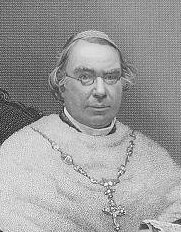|
John Brande Morris
John Brande Morris, known to friends as Jack Morris (born at Brentford, Middlesex, 4 September 1812; died at Hammersmith, London, 9 April 1880) was an English Anglican theologian, later a Roman Catholic priest. He was a noted academic eccentric, but an important scholar of Syriac. Life He studied at Balliol College, Oxford, graduating in 1834 (B.A. honours) and 1837 (M.A.). He was then elected Petrean Fellow of Exeter College, Oxford, lecturing on Hebrew and Syriac. Having joined the Tractarian Movement, in 1839 Morris was briefly left to deputize for John Henry Newman at St Mary's, Oxford, the university church: he alarmed his audience with a sermon on angels and fasting, "declaring ''inter alia'' that the brute creation should be made to fast on fast days". His next sermon, which preached the doctrine of transubstantiation, and "added in energetic terms that everyone was an unbeliever, carnal, and so forth, who did not hold it", earned him an admonition from the university v ... [...More Info...] [...Related Items...] OR: [Wikipedia] [Google] [Baidu] |
Brentford
Brentford is a suburban town in West (London sub region), West London, England and part of the London Borough of Hounslow. It lies at the confluence of the River Brent and the River Thames, Thames, west of Charing Cross. Its economy has diverse company headquarters buildings which mark the start of the M4 corridor; in transport it also has two railway stations and Boston Manor tube station, Boston Manor Underground station on its northwest border with Hanwell. Brentford has a convenience shopping and dining venue grid of streets at its centre. Brentford at the start of the 21st century attracted regeneration of its little-used warehouse premises and docks including the remodelling of the waterfront to provide more economically active shops, townhouses and apartments, some of which comprise Brentford Dock. A 19th- and 20th-century mixed social and private housing locality, New Brentford is contiguous with the Osterley neighbourhood of Isleworth and Syon Park and the Great Wes ... [...More Info...] [...Related Items...] OR: [Wikipedia] [Google] [Baidu] |
Prior Park College
Prior Park College is a co-educational public school for both boarding and day pupils in Bath, south-west England. Its main building, Prior Park, stands on a hill overlooking the city and is a Grade I listed building. The adjoining Prior Park Landscape Garden was donated by Prior Park to the National Trust. The school's parent body is Prior Park Schools, which also runs the Paragon Junior School (Bath) and Prior Park School Gibraltar. Overview Prior Park College provides co-educational schooling for students aged 11 to 18. Founded in 1830 to be England's first Catholic university, it was established by the Benedictine, Bishop Baines, as a seminary. The school kept its links with the Catholic diocese – which meant pupils were required to study Religious Education to GCSE level – until 2024. By that time the proportion of students of the Catholic faith had decreased to 18%, and the school is now described as Christian. In July 2009, Giles Mercer retired. He had been he ... [...More Info...] [...Related Items...] OR: [Wikipedia] [Google] [Baidu] |
The Lamp (periodical)
Lamp, Lamps or LAMP may refer to: Lighting * Oil lamp, using an oil-based fuel source * Kerosene lamp, using kerosene as a fuel * Electric lamp, or light bulb, a replaceable component that produces light from electricity * Light fixture, or light fitting or luminaire, is an electrical device containing an electric lamp that provides illumination * Signal lamp, or Aldis lamp or Morse lamp, a semaphore system for optical communication * Safety lamp, any of several types of lamp that provides illumination in coal mines ** Davy lamp Arts, entertainment and media Film and television * ''The Lamp'' (1987 film), or ''The Outing'', a horror film * ''The Lamp'' (2011 film), an American drama * ''Lamp'' (advertisement), a 2002 television and cinema advertisement for IKEA Music * Lamp (band), a Japanese indie band * "Lamp", a song by Bump of Chicken from the 1999 album '' The Living Dead'' Literature * ''Lamp'', a newspaper in Delaware * ''The Lamp'' (magazine), American bimonthly ... [...More Info...] [...Related Items...] OR: [Wikipedia] [Google] [Baidu] |
Dublin Review (Catholic Periodical)
The ''Dublin Review'' was a Catholic periodical founded in 1836 by Michael Joseph Quin, Cardinal Nicholas Wiseman and Daniel O'Connell. The fame of the "Edinburgh Review" suggested a territorial title, and Dublin was chosen as a great Catholic centre, though from the first it was edited and published in London. History Quin had the original idea for the new journal, soon persuading Wiseman to lend his support, and next enlisting O'Connell whose Catholic Emancipation campaign he admired. Of its first beginnings, Cardinal Wiseman wrote: "It was in 1836 that the idea of commencing a Catholic Quarterly was first conceived by the late learned and excellent Mr. Quin, who applied to the illustrious O'Connell and myself to join in the undertaking". Quin became the editor and chief contributor, writing five articles in the first number and four in the second. But the enterprise was not remunerative. After two numbers he resigned the editorship, being unable to devote so much time and ... [...More Info...] [...Related Items...] OR: [Wikipedia] [Google] [Baidu] |
Library Of The Fathers
The ''Library of the Fathers'', more properly ''A library of fathers of the holy Catholic church: anterior to the division of the East and West'', was a series of around 50 volumes of the Church Fathers, annotated in English translation, published 1838 to 1881 by John Henry Parker. Edited by Edward Bouverie Pusey and others including John Keble and John Henry Newman, this series of editions is closely associated with the origins of the Oxford Movement. Overview The series was planned by Pusey in summer 1836, and Pusey, Keble and Newman jointly signed the Prospectus which announced it. Over 600 subscribers had been secured by 1838, including nine English bishops as well as both Archbishops, William Howley and Edward Venables-Vernon-Harcourt.Richard W. Pfaff, The Library of the Fathers: The Tractarians as Patristic Translators, ''Studies in Philology'', Vol. 70, No. 3 (Jul., 1973), pp. 329-344 By 1853 thirty-seven volumes had appeared, and the number of listed subscribers had doubl ... [...More Info...] [...Related Items...] OR: [Wikipedia] [Google] [Baidu] |
John Chrysostom
John Chrysostom (; ; – 14 September 407) was an important Church Father who served as archbishop of Constantinople. He is known for his preaching and public speaking, his denunciation of abuse of authority by both ecclesiastical and political leaders, his '' Divine Liturgy of Saint John Chrysostom'', and his ascetic sensibilities. He was also the author of '' Adversus Judaeos'' and was strongly anti-Judaism. The epithet (''Chrysostomos'', anglicized as Chrysostom) means "golden-mouthed" in Greek and denotes his celebrated eloquence. Chrysostom was among the most prolific authors in the early Christian Church. He is honored as a saint in the Eastern Orthodox, Oriental Orthodox, Catholic, Anglican, and Lutheran churches, as well as in some others. The Eastern Orthodox, together with the Byzantine Catholics, hold him in special regard as one of the Three Holy Hierarchs (alongside Basil of Caesarea and Gregory of Nazianzus). Along with them and Athanasius of Alexa ... [...More Info...] [...Related Items...] OR: [Wikipedia] [Google] [Baidu] |
Patristic
Patristics, also known as Patrology, is a branch of theological studies focused on the writings and teachings of the Church Fathers, between the 1st to 8th centuries CE. Scholars analyze texts from both orthodox and heretical authors. Patristics emerged as a distinct discipline in the 19th century, supported by critical editions like Patrologia Latina and Patrologia Graeca. The field employs textual analysis, archaeology, and historical criticism to analyze early Christianity's doctrinal, cultural, and intellectual development, incorporating traditions beyond Greek and Latin, such as Syriac, Coptic, Armenian, and Ethiopian. Etymology Patrology, derived from the Latin (father) and Greek ''logos'' (discourse), primarily refers to the study of the Church Fathers and serves as an introduction to early Christian writings. Historically, it also included large compilations of these writings, such as ''Patrologia Latina'' and '' Patrologia Graeca'' by Migne.Stausberg, M., & Vevaina, Y. ... [...More Info...] [...Related Items...] OR: [Wikipedia] [Google] [Baidu] |
Coventry Patmore
Coventry Kersey Dighton Patmore (23 July 1823 – 26 November 1896) was an English poet and critic, literary critic. He is best known for his book of poetry ''The Angel in the House'', a narrative poem about the Victorian era, Victorian ideal of a happy marriage. As a young man, Patmore worked for the British Museum in London. After the publication of his first book of poems in 1844, he became acquainted with members of the Pre-Raphaelite Brotherhood. His grief over the death of his first wife, Emily Augusta Patmore in 1862, became a major theme in his poetry. Early life The eldest son of author Peter George Patmore, Coventry Patmore was born at Woodford, London, Woodford in Essex, England, EssexMeynell, Alice. "Coventry Patmore." The Catholic Encyclopedia Vol. 11. New York: Robert Appleton Compan ... [...More Info...] [...Related Items...] OR: [Wikipedia] [Google] [Baidu] |
Blessed Virgin Mary
Mary was a first-century Jewish woman of Nazareth, the wife of Saint Joseph, Joseph and the mother of Jesus. She is an important figure of Christianity, venerated under titles of Mary, mother of Jesus, various titles such as Perpetual virginity of Mary, virgin or Queen of Heaven, queen, many of them mentioned in the Litany of Loreto. The Eastern Orthodox Church, Eastern and Oriental Orthodox, Catholic, Anglican, Methodist, Reformed Christianity, Reformed, Baptist, and Lutheran churches believe that Mary, as mother of Jesus, is the Theotokos, Mother of God. The Church of the East historically regarded her as Christotokos, a term still used in Assyrian Church of the East liturgy. Other Protestant views on Mary vary, with some holding her to have lesser status. She has the Mary in Islam, highest position in Islam among all women and is mentioned numerous times in the Quran, including in a chapter Maryam (surah), named after her.Jestice, Phyllis G. ''Holy people of the world: a cros ... [...More Info...] [...Related Items...] OR: [Wikipedia] [Google] [Baidu] |
Breasts
The breasts are two prominences located on the upper ventral region of the torso among humans and other primates. Both sexes develop breasts from the same embryology, embryological tissues. The relative size and development of the breasts is a major secondary sex distinction between females and males. There is also considerable Bra size, variation in size between individuals. Permanent Breast development, breast growth during puberty is caused by estrogens in conjunction with the growth hormone. Female humans are the only mammals that permanently develop breasts at puberty; all other mammals develop their mammary tissue during the latter period of pregnancy. In females, the breast serves as the mammary gland, which produces and secretes milk to feed infants. Subcutaneous fat covers and envelops a network of lactiferous duct, ducts that converge on the nipple, and these tissue (biology), tissues give the breast its distinct size and globular shape. At the ends of the ducts are ... [...More Info...] [...Related Items...] OR: [Wikipedia] [Google] [Baidu] |
Sir John Acton
John Emerich Edward Dalberg-Acton, 1st Baron Acton, 13th Marquess of Groppoli, (10 January 1834 – 19 June 1902), better known as Lord Acton, was an English Catholic historian, Liberal politician, and writer. A strong advocate for individual liberty, Acton is best known for his timeless observation on the dangers of concentrated authority. In an 1887 letter to an Anglican bishop, he famously wrote, "Power tends to corrupt, and absolute power corrupts absolutely,"Letter to Bishop Mandell Creighton, April 5, 1887 Transcript of, published in ''Historical Essays and Studies'', edited by J. N. Figgis and R. V. Laurence (London: Macmillan, 1907). underscoring his belief that unchecked power poses the greatest threat to [...More Info...] [...Related Items...] OR: [Wikipedia] [Google] [Baidu] |





